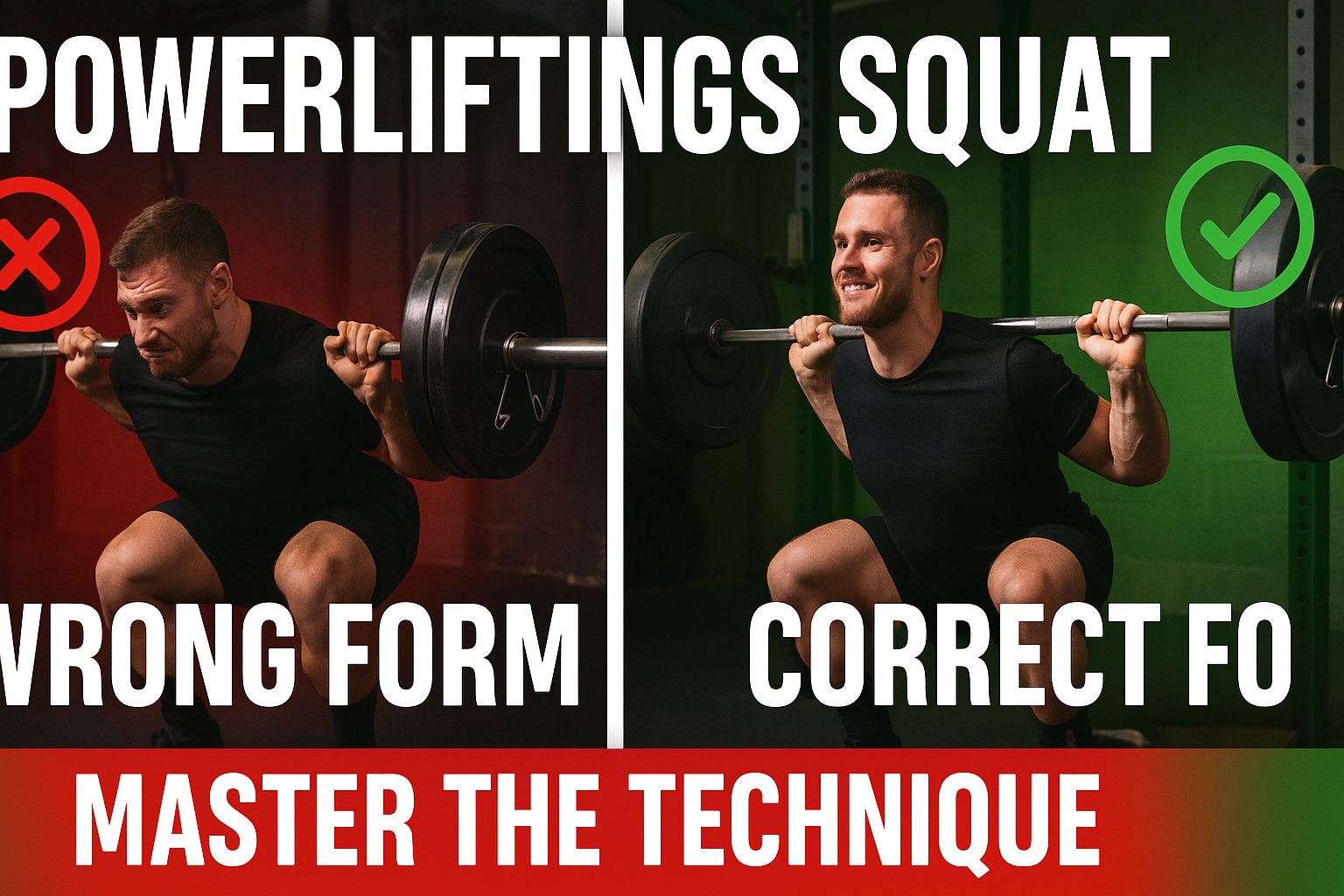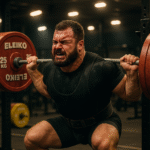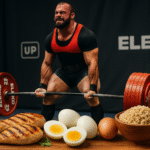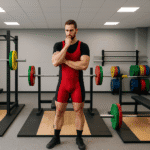The powerlifting squat is often called the “king of all exercises” – and for good reason. This fundamental movement builds incredible lower body strength, enhances athletic performance, and forms the cornerstone of competitive powerlifting. Whether you’re a beginner learning the basics or an experienced lifter looking to refine your technique, mastering the powerlifting squat is essential for maximizing your strength potential.

What Makes the Powerlifting Squat Different?
The powerlifting squat differs from other squat variations in its emphasis on moving maximum weight while adhering to specific competition rules. Unlike bodybuilding squats that focus on muscle isolation, or Olympic lifting squats that prioritize speed and mobility, the powerlifting squat is designed purely for strength expression within defined parameters.
In powerlifting competition, the squat must meet three key criteria: the lifter must descend until the hip crease drops below the knee cap, maintain control throughout the movement, and return to a fully upright position upon command. This creates a unique technical challenge that requires both raw strength and precise execution.
Essential Equipment for Powerlifting Squats
The Barbell and Plates
A regulation Olympic barbell weighing 45 pounds (20kg) is standard for powerlifting. The barbell should have aggressive knurling to prevent slipping and center knurl marks for proper positioning. Quality bumper plates or iron plates ensure consistent loading and proper weight distribution.
Power Rack or Squat Stand
Safety is paramount in powerlifting squats. A sturdy power rack with adjustable safety bars set just below your lowest squat position can prevent serious injury during failed attempts. The rack should also have adjustable J-hooks positioned at the appropriate height for your setup.
Powerlifting Shoes
Proper footwear makes a significant difference in squat performance. Powerlifting shoes feature a raised heel (typically 0.5-1 inch) that improves ankle mobility and allows for a more upright torso position. The rigid sole provides a stable platform for force transfer, while the secure fit prevents foot movement during heavy lifts.

Supportive Gear
A quality lifting belt helps maintain intra-abdominal pressure during heavy squats, providing core stability and injury prevention. Knee sleeves offer joint warmth and mild support, while some lifters prefer knee wraps for maximum assistance. Wrist wraps can help maintain proper bar position for those with limited shoulder mobility.
Step-by-Step Powerlifting Squat Technique
1. Bar Position and Setup
The powerlifting squat typically uses a low bar position, where the barbell rests on the posterior deltoids rather than the upper trapezius. This position allows for a more horizontal torso angle and engages the posterior chain more effectively, leading to heavier loads.
Approach the bar and position yourself directly underneath it. Grip the bar with both hands slightly wider than shoulder-width, creating a shelf with your upper back muscles. The bar should sit securely in the groove created by your contracted rear delts and rhomboids.
2. Unracking the Weight
Step under the bar and position it correctly on your back. Ensure your feet are directly under the bar, roughly shoulder-width apart. Stand up smoothly to lift the weight off the J-hooks, taking a moment to stabilize before stepping back.
Take three deliberate steps backward: right foot back, left foot back, then adjust as needed. This minimizes energy expenditure and maintains your position relative to the safety bars.
3. Stance and Foot Position
Your stance width should accommodate your individual anatomy and mobility. Most powerlifters use a stance slightly wider than shoulder-width, with toes pointed outward 15-30 degrees. This position allows for optimal hip and knee tracking while maximizing stability.
The foot position creates the foundation for the entire lift. Your weight should be distributed across the entire foot, with particular emphasis on driving through the heel and outer edge. Avoid lifting onto your toes or collapsing inward on your arches.
4. Breathing and Bracing
Proper breathing technique is crucial for heavy squats. Take a deep breath at the top of the movement, filling your lungs completely. Hold this breath while bracing your core as if someone were about to punch you in the stomach. This creates intra-abdominal pressure that stabilizes your spine and transfers force more efficiently.
Maintain this breath and brace throughout the entire repetition, only exhaling after you’ve returned to the starting position. For multiple repetitions, you can choose to breathe at the top or maintain the breath for several reps, depending on your comfort and the weight being used.
5. The Descent
Initiate the movement by simultaneously pushing your hips back and bending at the knees. The descent should be controlled but not artificially slow – typically taking 2-3 seconds to reach the bottom position. Maintain your chest position and avoid excessive forward lean.
Your knees should track in line with your toes throughout the movement. Avoid letting them cave inward (valgus collapse) or push excessively outward. The goal is smooth, consistent tracking that follows your natural joint alignment.
6. Achieving Proper Depth
Competition depth requires the hip crease to drop below the top of the kneecap. This is deeper than many recreational lifters are accustomed to, requiring adequate mobility in the ankles, knees, and hips. Practice achieving this depth with lighter weights before attempting heavy loads.
The bottom position should feel stable and controlled. If you’re crashing into the bottom or bouncing excessively, you may need to work on mobility or adjust your technique. The transition from descent to ascent should be smooth and deliberate.

7. The Ascent
Drive through your entire foot to initiate the upward movement, focusing on pushing the floor away rather than lifting the weight up. Maintain your back angle from the bottom position – avoid shooting your hips up first, which would cause your torso to fold forward excessively.
The ascent should mirror the descent in terms of knee and hip tracking. Maintain tension throughout your body and continue driving until you reach the fully upright position. The lift isn’t complete until you’re standing tall with hips and knees fully extended.
Common Powerlifting Squat Mistakes
Forward Knee Travel
While some forward knee movement is natural and necessary, excessive forward travel can compromise your position and reduce power output. Focus on initiating the movement with your hips while allowing your knees to bend naturally within your comfortable range of motion.
Inadequate Depth
Failing to reach competition depth is one of the most common errors in powerlifting training. Consistently practicing proper depth ensures you’ll make successful attempts in competition and maximizes the strength-building benefits of the exercise.

Losing Tightness
Maintaining full-body tension throughout the lift is crucial for both performance and safety. Any loss of tightness in your upper back, core, or lower body can compromise the lift and increase injury risk. Practice bracing techniques and focus on maintaining position under lighter loads.
Inconsistent Tempo
While you don’t need to squat extremely slowly, maintaining a consistent tempo helps with timing and control. Avoid rapid descents followed by slow ascents, or vice versa. Develop a rhythm that you can repeat consistently across all your training weights.
Programming the Powerlifting Squat
Frequency and Volume
Most powerlifters squat 2-3 times per week, allowing adequate recovery between sessions while maintaining skill and strength development. The total weekly volume typically ranges from 12-25 working sets, depending on your experience level and current training phase.
Intensity Ranges
Powerlifting training utilizes various intensity ranges to develop different aspects of strength. Heavy singles and doubles (90-100% 1RM) build maximum strength and competition readiness, while moderate loads (70-85% 1RM) develop strength endurance and technical proficiency.
Periodization
Successful powerlifting programs follow some form of periodization, gradually increasing intensity while managing fatigue. This might involve linear progression for beginners, block periodization for intermediate lifters, or more complex conjugate methods for advanced athletes.

Mobility and Accessory Work
Essential Mobility Requirements
The powerlifting squat demands adequate mobility in several key areas. Ankle dorsiflexion allows you to maintain an upright shin angle, hip flexion enables proper depth, and thoracic spine extension helps maintain chest position with a low bar placement.
Regular mobility work should target these areas specifically. Calf stretches, hip flexor stretches, and thoracic spine extensions can all contribute to improved squat performance. However, remember that stability is equally important – mobility without strength and control can be counterproductive.
Valuable Accessory Exercises
Accessory movements should address your individual weaknesses and support your main squat training. Front squats can improve quadriceps strength and upper back stability, while Romanian deadlifts develop posterior chain strength and hip hinge patterns.
Unilateral exercises like lunges and step-ups can address imbalances between sides, while core strengthening exercises support your ability to maintain proper bracing under heavy loads. Choose accessories based on your specific needs rather than following a generic template.
Safety Considerations
Proper Warm-Up Protocol
Never attempt heavy squats without an adequate warm-up. Begin with general movement patterns and light cardio to increase body temperature, then progress through dynamic stretches targeting the major muscle groups involved in squatting.
Your squat-specific warm-up should include bodyweight squats, goblet squats, and gradually increasing loads on the barbell. This progression prepares your nervous system for heavy loads while allowing you to assess your mobility and readiness for the training session.

Spotting and Safety Equipment
While spotting a squat can be challenging due to the movement pattern, proper safety equipment is essential. Set safety bars at an appropriate height – they should catch the bar if you fail at the bottom of the squat but not interfere with your normal range of motion.
If training with a spotter, ensure they understand proper spotting technique. The spotter should be positioned behind you and assist by supporting your torso rather than trying to lift the barbell. Clear communication about when you need assistance is crucial for safety.
Recognizing When to Stop
Learn to recognize the signs that indicate you should end your training session or avoid attempting a lift. Excessive fatigue, joint pain, or significant technique breakdown are all signals that continuing could lead to injury.
It’s better to end a session early than to push through and risk setbacks. Consistency in training over months and years is more valuable than any single training session, no matter how motivated you feel in the moment.
Competition Considerations
Understanding the Rules
If you plan to compete in powerlifting, familiarize yourself with the specific rules of your chosen federation. While the basic requirements are similar across organizations, details about equipment, commands, and judging criteria can vary significantly.
Practice responding to competition commands during your training. The “start,” “squat,” and “rack” commands create a different rhythm than training at your own pace, and familiarity with this timing can improve your competition performance.
Equipment Regulations
Competition equipment must meet specific standards for approval. Your belt, shoes, knee sleeves, and other gear should be checked against your federation’s approved equipment list well before competition day.
Consider investing in quality equipment that meets multiple federation standards if you’re unsure which organization you’ll compete with. While gear doesn’t make the lifter, having reliable, legal equipment eliminates unnecessary variables on competition day.

Conclusion
The powerlifting squat is a complex movement that rewards careful attention to technique, consistent practice, and intelligent programming. While the basic pattern may seem straightforward, mastering the nuances that separate good squatters from great ones requires patience and dedication.
Focus on developing solid fundamentals before pursuing maximum loads. Perfect your setup, breathing, and movement patterns with lighter weights, then gradually progress as your strength and skill improve. Remember that powerlifting is a long-term pursuit – small, consistent improvements compound over time to produce remarkable results.
Whether your goal is competing on the platform or simply building impressive strength, the powerlifting squat offers an unparalleled challenge and reward. Embrace the process, stay consistent with your training, and enjoy the journey toward becoming a truly accomplished powerlifter.
FAQs
What’s the difference between a powerlifting squat and a regular squat?
The powerlifting squat emphasizes moving maximum weight while adhering to specific competition rules. It typically uses a low bar position (barbell on posterior deltoids), requires deeper depth (hip crease below knee cap), and focuses on strength expression rather than muscle isolation. Regular squats may prioritize different goals like muscle building or athletic performance.
How deep should I squat in powerlifting?
In powerlifting competition, you must squat until the hip crease drops below the top of your kneecap. This is typically deeper than most recreational lifters are used to. Practice achieving this depth consistently with lighter weights before attempting heavy loads, as insufficient depth results in failed lifts in competition.
Should I use high bar or low bar position for powerlifting?
Most powerlifters use the low bar position, where the barbell rests on the posterior deltoids rather than the upper traps. This position allows for a more horizontal torso angle, better leverages for moving heavy weight, and greater involvement of the posterior chain. However, some lifters may find high bar more comfortable based on their anatomy and mobility.
How often should I squat for powerlifting?
Most powerlifters squat 2-3 times per week. This frequency allows adequate recovery while maintaining skill development and strength gains. Beginners might start with 2 sessions per week, while advanced lifters may benefit from 3 sessions with varying intensities and volumes.
What equipment do I absolutely need for powerlifting squats?
Essential equipment includes: a regulation Olympic barbell (45 lbs/20kg), a power rack or squat stand with safety bars, and proper powerlifting shoes with raised heels. A lifting belt is highly recommended for heavy training. Knee sleeves, wrist wraps, and chalk are beneficial but not absolutely necessary for beginners.
How do I know if I’m squatting heavy enough for powerlifting?
Powerlifting training typically involves working at 70-100% of your one-rep maximum (1RM). If you’re new to powerlifting, focus on perfecting technique with moderate weights (60-80% 1RM) before attempting maximum loads. Progressive overload and consistent training will naturally lead to heavier weights over time.



